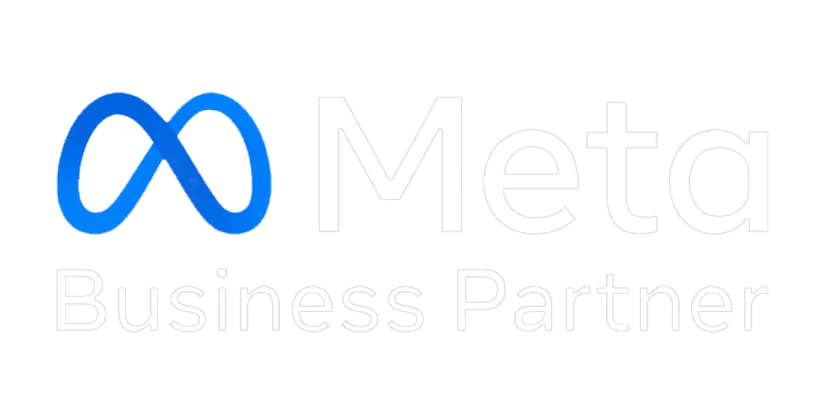Top WhatsApp Automation Workflows Every D2C Brand Should Use
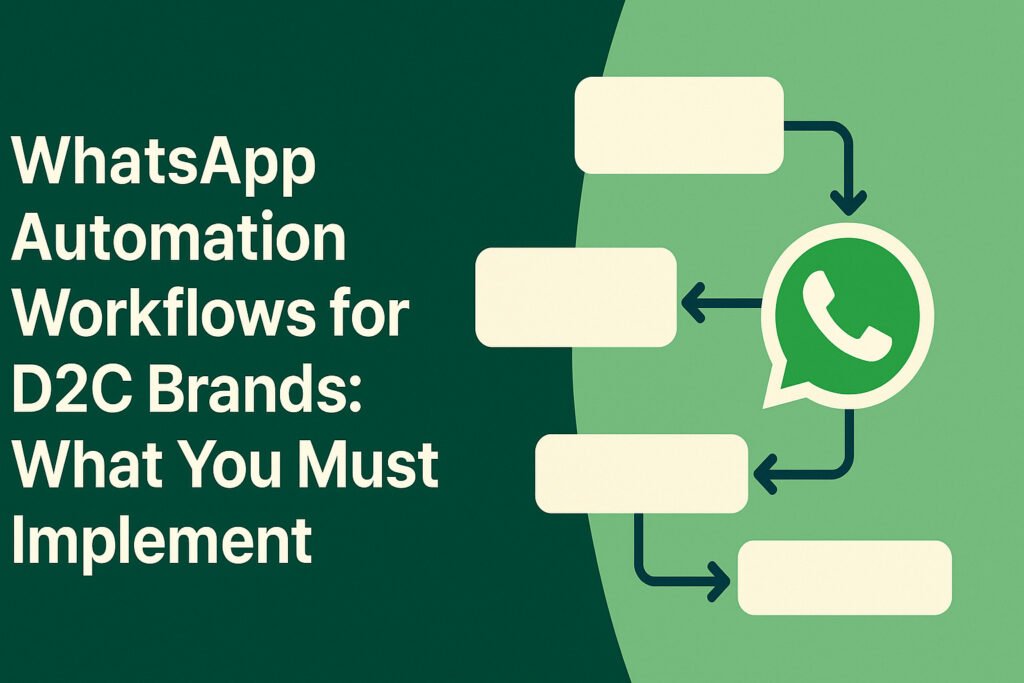
WhatsApp Automation Workflows for D2C Brands: What You Must Implement Direct-to-consumer (D2C) brands are constantly looking for new ways to increase customer engagement, drive conversions, and simplify operations. One of the most effective strategies to achieve all three is implementing WhatsApp automation workflows using the WhatsApp Business API. With the right workflows, your brand can respond faster, convert leads better, and create a more personalized shopping experience. In this blog, we explore the top WhatsApp automation workflows every D2C brand should use—and how TheBotMode can help you implement them effortlessly. 1. Welcome Message Workflow When a new customer messages your business or opts in via a landing page or ad, an automated welcome message builds instant connection. This workflow can: Why it matters: It creates a warm first impression and improves chances of conversion. 2. Abandoned Cart Reminder Workflow Many customers add products to cart but leave without purchasing. With WhatsApp automation, you can send personalized abandoned cart reminders to re-engage them. What to include: Why it matters: It helps recover lost sales and boosts revenue. 3. Order Confirmation and Shipping Updates Keep customers informed with real-time order updates: Why it matters: It reduces customer anxiety and support queries. 4. COD to Prepaid Conversion Workflow Cash on Delivery (COD) leads to high Return-to-Origin (RTO) rates. WhatsApp can help you nudge COD buyers to convert to prepaid using automation. How it works: Why it matters: Reduces RTO losses and improves cash flow. 5. Feedback and Review Collection Workflow After delivery, WhatsApp can be used to request a quick product review or feedback. You can ask: Why it matters: Social proof builds trust and improves product listings. 6. Reorder and Subscription Reminder Workflow If you sell products with repeat usage (like supplements, skincare, etc.), this workflow is crucial. Automate: Why it matters: It boosts customer retention and lifetime value. 7. Festival and Sale Campaigns Workflow Automate festive campaign workflows to notify customers during key sales: Why it matters: WhatsApp has higher open rates than email, making it perfect for time-sensitive promotions. 8. Customer Support Workflow (Auto-Reply + Live Agent Handoff) Use WhatsApp to provide 24×7 support with automated responses for FAQs and quick escalation to agents. Example: Why it matters: Reduces support load and improves customer satisfaction. How TheBotMode Simplifies WhatsApp Automation TheBotMode allows D2C brands to build, test, and optimize WhatsApp workflows with zero coding. With features like: You get everything you need to launch high-converting WhatsApp automation flows. FAQs Q1. Do I need coding knowledge to create WhatsApp automation workflows? No. With platforms like TheBotMode, you can build automation flows using a visual interface—no coding required. Q2. Can I send WhatsApp messages without customer opt-in? No. According to WhatsApp’s policy, businesses must collect customer opt-ins before initiating automated messages. Q3. How much does WhatsApp automation cost for a D2C brand? Costs vary depending on the platform and usage. TheBotMode offers affordable plans tailored for D2C businesses of all sizes. Q4. Is WhatsApp automation effective for small D2C brands? Yes. Even small brands can automate cart recovery, order updates, and customer support to increase efficiency and revenue. Q5. How do I measure the success of WhatsApp automation workflows? Track key metrics like open rates, click-through rates, conversions, and RTO reduction using TheBotMode’s analytics dashboard.
Festival Marketing on WhatsApp: Campaign Ideas That Work
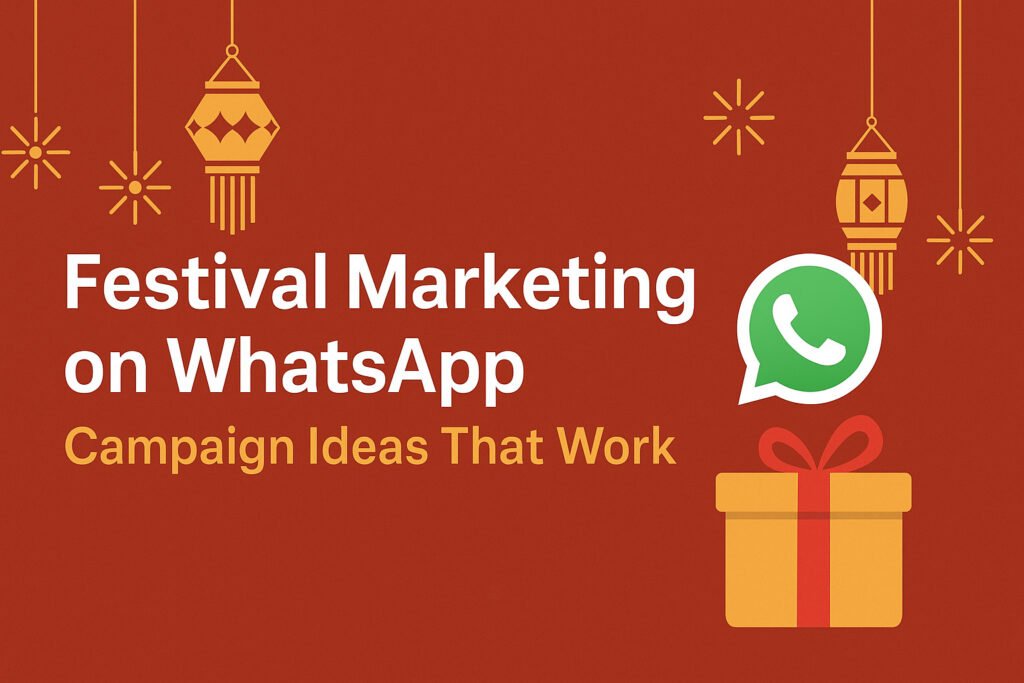
Introduction: In India, festivals are far more than cultural events—they’re peak sales opportunities. From Diwali and Holi to Eid, Christmas, and Raksha Bandhan, consumers are primed to shop. For D2C brands, leveraging WhatsApp for festival marketing can significantly boost engagement, sales, and customer loyalty. Using TheBotMode’s WhatsApp automation tools enables timely, personalized campaigns delivered straight into customers’ inboxes—minimizing reliance on emails or ads. Top Festival Campaign Ideas That Deliver Results 1. Exclusive Festival Offers via WhatsApp Broadcast Send time-sensitive promotional messages to your WhatsApp subscriber list—segment audiences and personalize by name, location, or past purchases. Example: “Hi Riya, celebrate Diwali with 20% off on your favourite kurtis. Offer valid till midnight!” Why it works: High open rates + urgency = instant action. 2. Spin the Wheel Campaigns for Festival Discounts Create interactive gamified campaigns on WhatsApp where users spin to win festival-themed deals like free shipping, limited discounts, or freebies. Best for: Diwali, Navratri, Christmas and festive markets. Advantages with TheBotMode: Run spin-to-win campaigns directly on WhatsApp—no app downloads required. 3. WhatsApp Catalog Promotions with Festive Themes Showcase curated festive collections (e.g. “Diwali Gifting Ideas”, “Eid Special Offers”) in WhatsApp product catalogs, styled with festive banners or limited-time labels like “Only 2 left!” Pro Tip: Use high-quality visuals to guide users and boost urgency. 4. Automated Reminder Campaigns Set up flows to remind customers about cart abandonment or deal expirations. Example Automation Flow: 5. Personalized Gifting Recommendations via WhatsApp Use TheBotMode’s AI logic to suggest tailored gift ideas during festivals like Raksha Bandhan, Valentine’s Day, and Christmas. Personalization drives engagement and purchase intent. 6. Festival Loyalty Campaigns with Rewards Encourage repeat purchases with special loyalty offers.Example: “Buy during Navratri and get double loyalty points!”Send point updates, coupon codes, and personalized rewards directly via WhatsApp. How TheBotMode Helps Automate Your Festival Campaigns Best Timing to Launch Festival Campaigns Festival Ideal Campaign Start Key Focus Diwali 2 weeks in advance Gift combos, flash sales Holi 1 week before Color collections, skincare essentials Raksha Bandhan 10 days beforehand Gift boxes, sibling discounts Eid 7–10 days before Fashion, home decor, accessories Christmas / New Year 2 weeks in advance Combo bundles, new arrivals Conclusion: Festival marketing via WhatsApp isn’t just optional—it’s a competitive advantage. With powerful engagement tools, immediate delivery, and automated flows, WhatsApp enables D2C brands to connect during key buying moments. TheBotMode simplifies launch, automation, and scaling of festival campaigns—no coding required. Ready to launch your next festival campaign on WhatsApp?Visit TheBotMode.com and explore our pre‑built festive flows to get started.
Boost First‑Time Orders with Spin the Wheel Coupons on WhatsApp
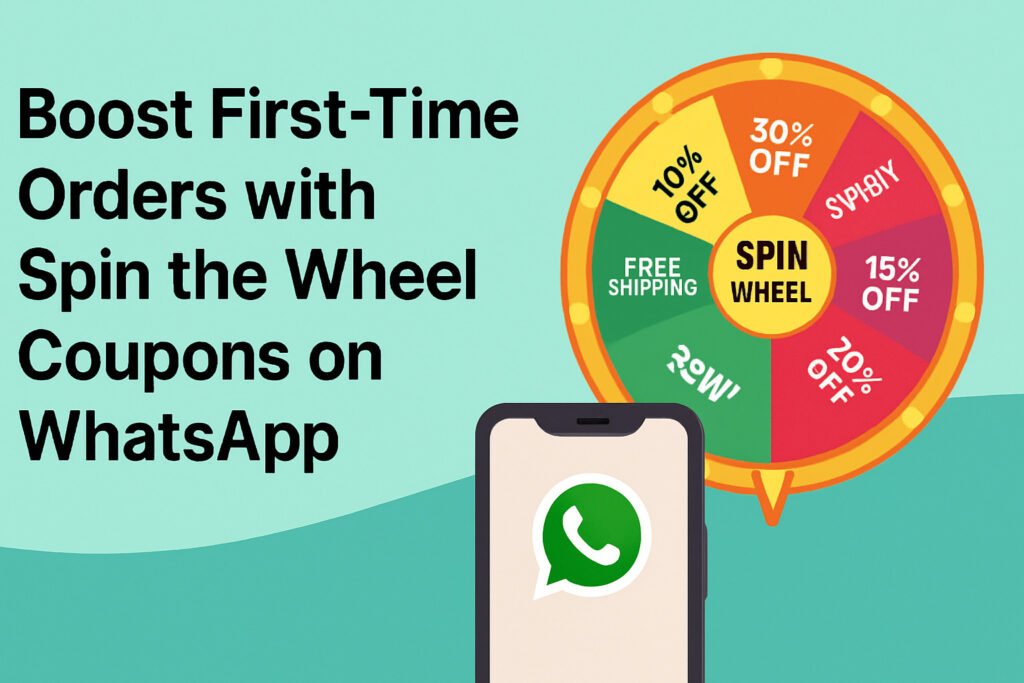
Introduction: Why First‑Time Orders Matter for D2C Brands For direct‑to‑consumer (D2C) businesses, converting new visitors into first‑time customers is often the most challenging and expensive phase of the funnel. Standard discount pop‑ups and static offers are frequently ignored. Enter Spin the Wheel gamification on WhatsApp—an interactive, engaging, and high‑conversion strategy that stands out. What Is Spin the Wheel for WhatsApp? Spin the Wheel is an interactive lead‑capture mechanism where users spin a virtual wheel to win a discount or reward. When integrated with WhatsApp automation through TheBotMode, this becomes a powerful system to convert first‑time visitors into buyers. Embed the widget on your website and deliver the winning coupon instantly via WhatsApp, creating a frictionless experience that builds trust and sparks action. Why Use Spin the Wheel Coupons on WhatsApp? 1. Higher Engagement Rates Gamified offers attract far more attention than static banners—users enjoy the interactive nature of spinning a wheel more than a standard discount notification. 2. Immediate Lead Capture To spin the wheel, visitors must submit their phone number. This enables you to grow a qualified, opted‑in list instantly and organically via WhatsApp. 3. Fast and Direct Coupon Delivery WhatsApp automation ensures personalized coupon codes land immediately in the user’s inbox—enhancing open rates and driving swift action. 4. Real‑Time FOMO Rewards Limited‑time coupons (e.g. valid for just 15–30 minutes) trigger urgency and prompt customers to act fast before the opportunity passes. How to Set Up Spin the Wheel Coupons with WhatsApp Step 1: Create Your Spin the Wheel Widget Use TheBotMode’s gamification plugin or a compatible third‑party widget. Configure the wheel with 3–5 reward tiers (e.g. 10%, 15%, 20% off or free shipping). Step 2: Connect It to WhatsApp Automation Integrate the widget using TheBotMode’s WhatsApp API. Once users enter their phone numbers and spin, the system triggers automated coupon delivery instantly. Step 3: Design Your WhatsApp Message Flow Structure your messaging effectively: Step 4: Follow Up with Reminder Flows If a coupon isn’t redeemed within hours or by the next day, automatically send reminder messages—perhaps with a “last chance” bonus to capture conversions. Best Practices for Spin the Wheel Campaigns Real Results: A D2C Skincare Brand Case Study A skincare brand implemented TheBotMode’s Spin the Wheel widget on their homepage, offering 10–30% off coupons via WhatsApp: This gamified approach transformed passive browsers into engaged buyers—delivering measurable uplift in acquisition and conversion. Conclusion: Make First‑Time Purchases Engaging and Seamless By combining Spin the Wheel gamification with WhatsApp automation, D2C brands can create engaging, seamless funnels that drive first‑time purchases. With TheBotMode, you can easily build, automate, and measure these campaigns—boosting conversions and growing your WhatsApp marketing list with qualified leads.
WhatsApp for D2C
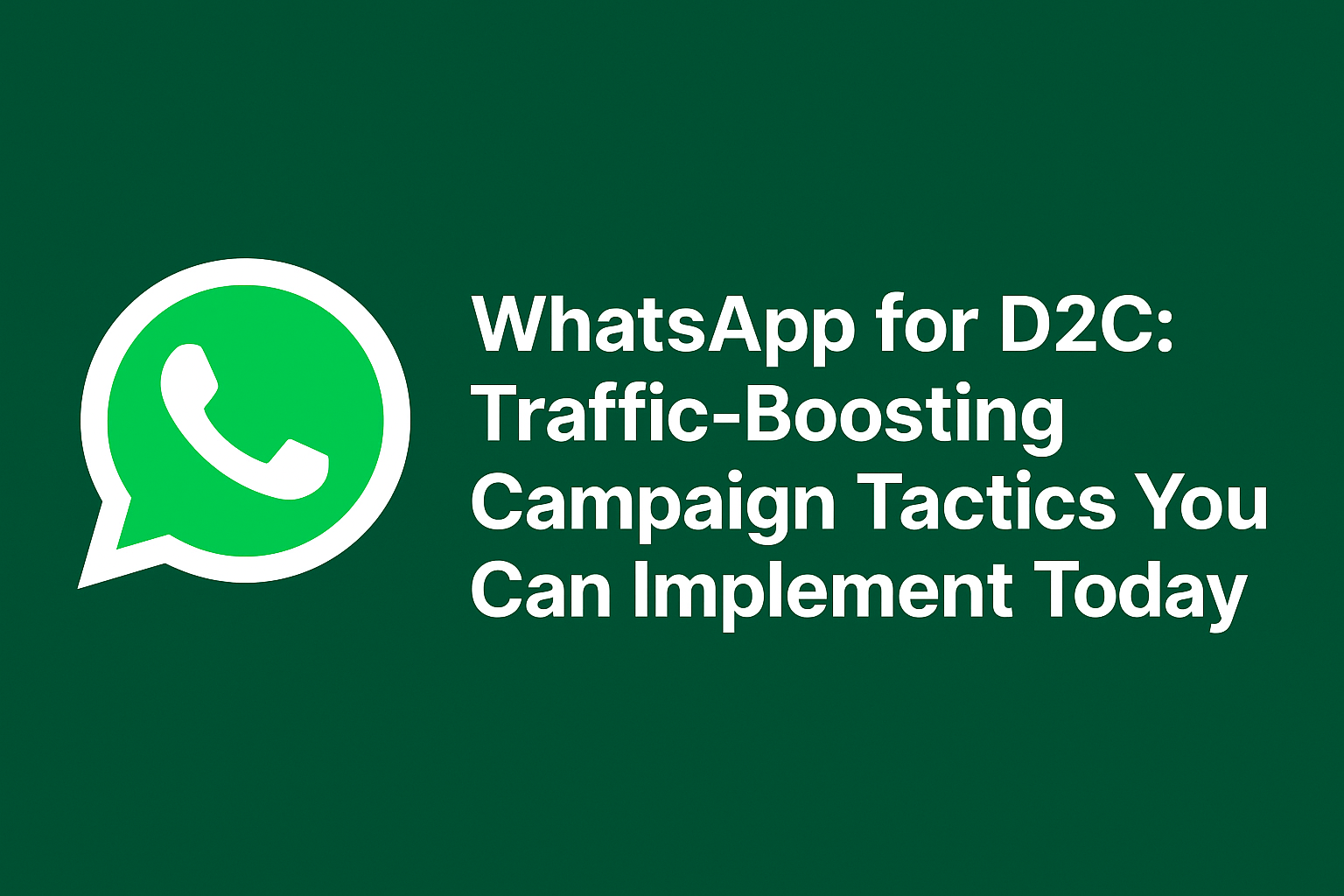
WhatsApp for D2C: Traffic‑Boosting Campaign Tactics You Can Implement Today Introduction In 2025, WhatsApp has become a conversion engine for D2C brands—powered by up to 98% open rates and 45–60% click-through rates, far outperforming email and SMS.This blog unpacks proven campaign tactics—focused on opt‑in, segmentation, automation, rich media, ads, payments, and analytics—that D2C brands can launch today to boost web traffic and sales. 1. Opt‑In Strategy: Foundation of Trust & Compliance WhatsApp mandates explicit opt‐in consent for marketing messages. Brands must collect and store consent via checkout flows, website pop‑ups, social channels, QR codes, and packaging inserts. This ensures compliance and higher engagement.Tips: 2. Segmentation & Personalization to Drive Engagement Segment contacts by behavior, purchase history, and demographics—including dynamic fields like names or previous purchases—to create messages that feel deeply personal. Personalization boosts engagement: nearly 72% of consumers engage more with personalized marketing messages.Strategic segmentation elevates both open and reply rates, driving more traffic and conversions. 3. Automation & Drip Campaigns for Scale Automate touchpoints with chatbots and workflow engines for: These interventions lower friction and replace manual outreach with scalable, personalized flows—with human-handover options for complex cases. 4. Rich Media & Conversational Campaign Content WhatsApp supports clickable buttons, product catalogs, PDFs, images and quick-reply options—all ideal for driving click-throughs to your site.Use broadcasts creatively: immersive storytelling, behind-the-scenes peeks, flash offers, or polls/quizzes to encourage replies and website visits. 5. Click‑to‑WhatsApp Ads & Conversational Lead Gen Run Click‑to‑WhatsApp ads on Facebook, Instagram, or your website to initiate conversations seamlessly. Prospects land directly in chat—now you can capture their name, phone number, and guide them to your site or product pages via interactive flows. 6. Payments & In‑Chat Checkout Enable in‑chat payments using UPI, Razorpay, WhatsApp Pay (especially effective in India), or payment links. This removes checkout friction and boosts conversions by keeping users inside WhatsApp rather than redirecting them. 7. Timing, Analytics & Continuous Optimization Send messages during peak engagement windows, not off-hours. Track metrics like delivery rate, open rate, CTR, reply rate, opt‑out rate, and conversions from WhatsApp chats to your site.Use A/B testing for timing, segmentation, CTA formats, and message content to optimize continuously. 8. Avoid Common WhatsApp Marketing Pitfalls Don’t broadcast unsolicited messages or reuse stale content. Avoid disreputable tools. Stick with providers using the official WhatsApp Business API to ensure deliverability, compliance, and analytics capability.Treat WhatsApp as a two-way channel, not a one-off broadcast list. 9. Real‑World D2C Examples That Drive Growth Conclusion WhatsApp isn’t just a support channel—it’s a full-funnel traffic and conversion powerhouse. By implementing compliant opt‑in, segmentation, smart automation, rich media campaigns, conversational ads, and integrated payments—and optimizing through analytics—you can drive significant website traffic and bottom-line growth now. Ready to launch? Let TheBotMode support your next WhatsApp campaign with tools, templates, and a conversion-focused strategy. FAQs Q: What makes WhatsApp marketing effective for D2C brands? WhatsApp delivers 98% open rates and 45–60% click-throughs, with 66% of users making a purchase after chatting with a brand—offering unmatched engagement compared to email or SMS. Q: How do I comply with opt‑in rules? Collect explicit consent during checkout or via pop‑ups/QR codes, inform customers what they’re subscribing to, enable easy opt‑out, and keep records to ensure compliance. Q: Which WhatsApp campaigns convert best? Campaigns with automation for cart recovery, welcome flows, query replies, and personalized promotions tend to outperform. Using rich media + CTA buttons further drives traffic. Q: How can I measure traffic from WhatsApp campaigns? Use platforms with built-in analytics to track delivery, CTR, opt-out, and conversions tied to chat links or promo codes. A/B test subject lines, timing, and segment variants. Q: Which tools support WhatsApp marketing for D2C brands? Choose providers that support the WhatsApp Business API, offer analytics, automation workflows, payment links, and template message support—ensuring compliance and scale.
How to Set Up COD‑to‑Prepaid via WhatsApp API (Step‑by‑Step)
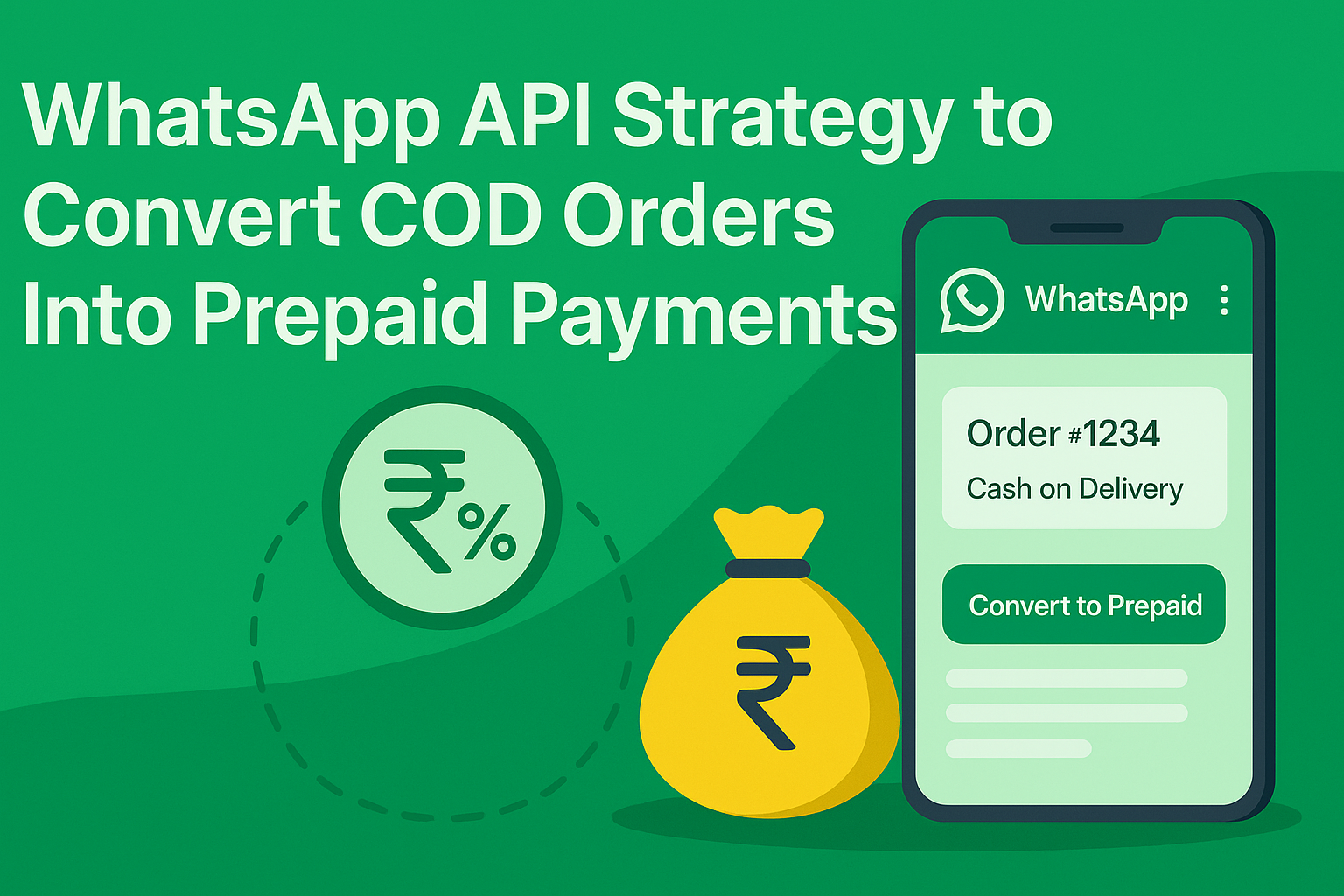
How to Set Up COD‑to‑Prepaid via WhatsApp API (Step‑by‑Step) Step 1: Choose Our Automation Platform Platforms like TheBotMode integrate with Shopify/WooCommerce, WhatsApp API, and payment gateways. Step 2: Configure Workflow & Templates Step 3: Payment Integration & Flow Logic Step 4: Launch Automation & Monitor Message Templates That Drive Conversion Example template frameworks (customize with your branding tone): Initial Nudge (0 hr): Hey [Name], your order #[OrderNumber] is confirmed. Prepay now and get ₹50 off + priority dispatch! Tap below to pay. [Pay Now] Reminder 1 (4 hrs): Quick reminder: ₹50 off offer ends soon. Prepay now: [Pay Now] Final Nudge (6 hrs): Last chance! Offer expires in 2 hrs. Secure your order now: [Pay Now] These follow-ups build urgency and clarity—Auric used this 3‑step structure and saw solid lift in conversions. Best Practices to Maximize Success & Reduce RTO 1. Incentives & Urgency Test flat vs. percentage discounts; highlight expiry to create FOMO. 2. Message Personalization Use buyer name and order ID to build trust—stronger than generic texts. 3. Pre‑confirm COD Intent Use OTPs or a quick WhatsApp opt‑in before launching conversion—cuts impulsive or fake orders. 4. Exclude High‑Risk Zones Leverage RTO analytics to disable COD options in poor-performing pin codes. 5. Monitor & Segment Track metrics closely by pincode, product, and customer. Handle exceptions manually or block repeat offenders. Metrics to Track (and Optimize) Metric Why It Matters COD → Prepaid Conversion Rate Gauge effectiveness of WhatsApp campaign RTO / NDR % Measure direct impact on return rates Incremental Prepaid Revenue Compare discounted vs. net gain Time to Payment Faster payments = better cash flow Message Read & Click Rates Optimize template/CTA for engagement Customer Satisfaction (CSAT/NPS) Ensure nudge flows don’t feel pushy Platforms like DelightChat and Interakt provide dashboards for these insights. Why TheBotMode Audience Should Care FAQ Q1: Will this work with Shopify or WooCommerce? Yes—platforms like DelightChat and Interakt sync both with Shopify and WooCommerce stores seamlessly. Q2: Do I need to offer a discount for conversions to work? Incentives improve conversion dramatically. Brands report 45–60% conversion when using discounts. Without a discount, conversions are still possible—just test messaging. Q3: How does the system know the customer paid? Payment links redirect to Shopify draft orders or Razorpay; once paid, the system tags and updates orders automatically. Q4: Can I tailor messaging by region or risk? Yes—most platforms let you segment templates by pincode or customer profile, allowing tailored flows for high-risk zones. Q5: What conversion rates should I expect? Standard is 5–10% for basic flows. With optimized drip campaigns (like Auric’s), brands have achieved 11% or higher, boosting prepaid volume by 27%. Conclusion Converting COD orders to prepaid via WhatsApp API is a smart, scalable way to reduce RTO, improve margins, and streamline fulfillment. With platforms like DelightChat, Interakt, AiSensy, or QuickReply.ai, you can automate this core workflow with minimal effort—and measurable returns. 🔗 Be sure to explore your internal tutorial: Convert COD Orders to Prepaid for implementation guidance. Step 1: Choose Our Automation Platform Platforms like TheBotMode integrate with Shopify/WooCommerce, WhatsApp API, and payment gateways. Step 2: Configure Workflow & Templates Step 3: Payment Integration & Flow Logic Step 4: Launch Automation & Monitor Message Templates That Drive Conversion Example template frameworks (customize with your branding tone): Initial Nudge (0 hr): Hey [Name], your order #[OrderNumber] is confirmed. Prepay now and get ₹50 off + priority dispatch! Tap below to pay. [Pay Now] Reminder 1 (4 hrs): Quick reminder: ₹50 off offer ends soon. Prepay now: [Pay Now] Final Nudge (6 hrs): Last chance! Offer expires in 2 hrs. Secure your order now: [Pay Now] These follow-ups build urgency and clarity—Auric used this 3‑step structure and saw solid lift in conversions. Best Practices to Maximize Success & Reduce RTO 1. Incentives & Urgency Test flat vs. percentage discounts; highlight expiry to create FOMO. 2. Message Personalization Use buyer name and order ID to build trust—stronger than generic texts. 3. Pre‑confirm COD Intent Use OTPs or a quick WhatsApp opt‑in before launching conversion—cuts impulsive or fake orders. 4. Exclude High‑Risk Zones Leverage RTO analytics to disable COD options in poor-performing pin codes. 5. Monitor & Segment Track metrics closely by pincode, product, and customer. Handle exceptions manually or block repeat offenders. Metrics to Track (and Optimize) Metric Why It Matters COD → Prepaid Conversion Rate Gauge effectiveness of WhatsApp campaign RTO / NDR % Measure direct impact on return rates Incremental Prepaid Revenue Compare discounted vs. net gain Time to Payment Faster payments = better cash flow Message Read & Click Rates Optimize template/CTA for engagement Customer Satisfaction (CSAT/NPS) Ensure nudge flows don’t feel pushy Platforms like DelightChat and Interakt provide dashboards for these insights. Why TheBotMode Audience Should Care FAQ Q1: Will this work with Shopify or WooCommerce? Yes—platforms like DelightChat and Interakt sync both with Shopify and WooCommerce stores seamlessly. Q2: Do I need to offer a discount for conversions to work? Incentives improve conversion dramatically. Brands report 45–60% conversion when using discounts. Without a discount, conversions are still possible—just test messaging. Q3: How does the system know the customer paid? Payment links redirect to Shopify draft orders or Razorpay; once paid, the system tags and updates orders automatically. Q4: Can I tailor messaging by region or risk? Yes—most platforms let you segment templates by pincode or customer profile, allowing tailored flows for high-risk zones. Q5: What conversion rates should I expect? Standard is 5–10% for basic flows. With optimized drip campaigns (like Auric’s), brands have achieved 11% or higher, boosting prepaid volume by 27%. Conclusion Converting COD orders to prepaid via WhatsApp API is a smart, scalable way to reduce RTO, improve margins, and streamline fulfillment. With platforms like DelightChat, Interakt, AiSensy, or QuickReply.ai, you can automate this core workflow with minimal effort—and measurable returns. 🔗 Be sure to explore your internal tutorial: Convert COD Orders to Prepaid for implementation guidance.
WhatsApp Blue Tick Benefits

WhatsApp Blue Tick Benefits: From Verification to Increased Engagement Introduction For D2C brands, building trust and fostering engagement are daily challenges. That’s where the WhatsApp Blue Tick comes in. A verified business account not only signals authenticity but also unlocks powerful features designed to boost open rates, streamline customer support, and ultimately drive sales. In this blog, we’ll explore exactly what the Blue Tick is, why it matters, and how you can apply for one right here on TheBotMode. Understanding the WhatsApp Verified Business Account What Is the Blue Tick vs. Green Tick? Eligibility Criteria Top Benefits of the WhatsApp Blue Tick for D2C Brands 1. Building Customer Trust and Credibility 2. Enhanced Brand Visibility and Recognition 3. Improved Customer Engagement 4. Streamlined Communication and Support Step-by-Step Application Process Prerequisites Application Steps Case Study: D2C Brand Success on TheBotMode Brand: GlowHive Skincare Maximizing Your Blue Tick Account Crafting Welcome Messages Leveraging Broadcast Lists Tracking Performance with Analytics Ready to Get Your Blue Tick? Give your D2C brand the credibility edge it deserves. Apply for a blue tick. Conclusion A WhatsApp Blue Tick is more than just a badge—it’s a trust accelerator, engagement booster, and brand differentiator all rolled into one. By following the steps above and leveraging advanced features like quick replies and bots, D2C brands can transform customer interactions into meaningful relationships that drive repeat business. Frequently Asked Questions What’s the difference between the Blue Tick and Green Tick? The Green Tick is the default label for any business on the WhatsApp Business App, while the Blue Tick indicates a fully verified and notable brand. How long does verification take? Expect 5–7 business days for Meta to review and approve your application. Can small D2C brands qualify? Absolutely—if you meet the eligibility criteria (Business Manager verification, policy compliance, and notability). Is there a fee for verification? There’s no direct fee for the Blue Tick itself, though some regions require a Meta Verified subscription for certain verification pathways.
How to Set Up Auto-Replies on WhatsApp for Faster Customer Support

Introduction In the fast-paced world of D2C commerce, slow response times can lead to lost sales and frustrated customers. WhatsApp has emerged as one of the most powerful communication channels for D2C brands—but managing hundreds of messages daily can quickly overwhelm your support team. This is where auto-replies come in. By setting up automated responses, you can instantly handle customer inquiries, answer FAQs, and provide support—even outside working hours. In this blog, you’ll learn how to set up auto-replies on WhatsApp and how TheBotMode enables D2C brands to deliver faster, smarter customer support. Step 1: Choose the Right WhatsApp Business Platform WhatsApp offers two versions for businesses: If your brand is scaling or requires advanced workflows, the WhatsApp Business API (integrated with TheBotMode) is the preferred option. Step 2: Set Up Auto-Replies in the WhatsApp Business App For brands using the free WhatsApp Business App, setting up auto-replies is quick: You can also set Quick Replies for FAQs: This helps manage common questions efficiently. Step 3: Use TheBotMode with WhatsApp API for Advanced Automation For D2C brands using the WhatsApp API, TheBotMode unlocks powerful auto-reply capabilities: This creates a responsive and personalized experience that scales with your business. Step 4: Design Auto-Reply Flows for Customer Journeys Here’s an example of an auto-reply flow used by successful D2C brands on TheBotMode: This reduces agent workload and delivers faster resolutions. Step 5: Monitor Performance with Analytics TheBotMode’s dashboard provides actionable insights, including: These metrics help you improve support efficiency and continuously refine your auto-reply logic. Benefits of WhatsApp Auto-Replies for D2C Brands Conclusion Setting up auto-replies on WhatsApp isn’t just about efficiency—it’s about creating an always-on customer experience that drives growth. Whether you’re using the WhatsApp Business App or integrating with the API, TheBotMode helps D2C brands automate conversations, provide instant support, and deliver seamless experiences at scale. Ready to level up your customer service? Let TheBotMode help you set up intelligent auto-replies that keep your brand responsive, professional, and available 24/7. FAQs Q1. Can I set auto-replies during non-working hours only? Yes, both the WhatsApp Business App and API support scheduled messages based on your business hours. Q2. Do auto-replies work in multiple languages? Yes. With TheBotMode, you can automatically detect the user’s language and respond accordingly. Q3. What makes TheBotMode different from other WhatsApp tools? TheBotMode is purpose-built for D2C brands, offering eCommerce-specific features like automated order tracking, payment handling, product catalogs, and customizable workflows—all in one powerful solution.
Top Mistakes D2C Brands Make with WhatsApp Automation — and How to Fix Them
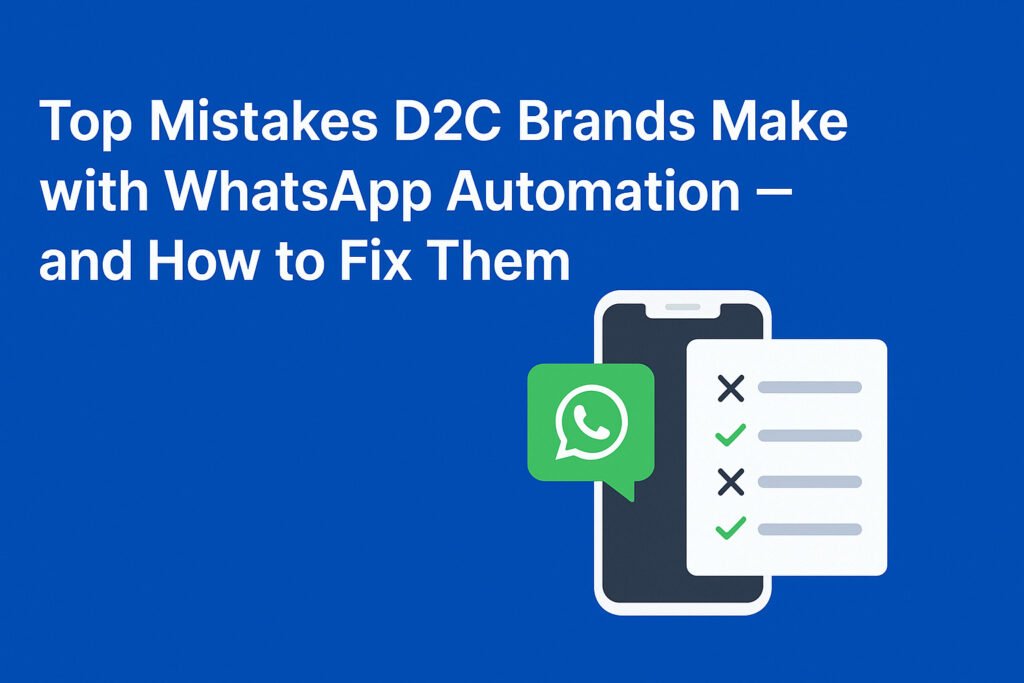
WhatsApp automation has quickly become a game-changer for D2C brands in India and around the world. With consumers increasingly preferring instant messaging over traditional emails or mobile apps, WhatsApp delivers unmatched engagement and conversion potential. But here’s the catch — when not executed correctly, automation can do more harm than good. From account bans to low engagement, D2C brands often fall into avoidable traps. In this blog, we’ll break down the most common WhatsApp automation mistakes and share practical solutions to help you drive better results with confidence and compliance. 1. Sending Bulk Messages Without Opt-in Mistake: Broadcasting messages to users who haven’t explicitly opted in.Impact: Violates WhatsApp’s Business Policy and can lead to account suspension or message delivery blocks. Fix: Always collect user consent before sending marketing messages. Use website pop-ups, checkout opt-ins, or Click-to-WhatsApp ads. Platforms like TheBotMode offer consent-based automation that ensures 100% compliance. 2. No Personalization in Message Flows Mistake: Using generic, one-size-fits-all templates such as “Hi, Buy Now!”.Impact: Poor engagement, low open rates, and increased opt-outs. Fix: Personalize every message with dynamic fields like customer name, product name, or order ID. Segment users based on behavior and lifecycle. For example:“Hi [Name], your order #[OrderID] is ready. Should we ship it today?” 3. Not Using Cart Recovery Automation Mistake: Ignoring cart abandoners in your WhatsApp flow.Impact: Missed opportunity to recover 60–70% of potential sales. Fix: Set up automated cart recovery messages triggered at intervals (e.g., 1 hour, 6 hours, and 24 hours post-abandonment). Include urgency or a small incentive. TheBotMode enables seamless Shopify cart recovery with zero manual setup. 4. Poor Timing of Campaign Messages Mistake: Sending messages at odd hours or when customers are inactive.Impact: Low visibility, muted responses, and user irritation. Fix: Schedule messages based on customer location and behavior patterns. Most D2C shoppers respond best between 10 AM–1 PM or 6 PM–8 PM. TheBotMode’s smart scheduler handles this automatically. 5. Over-Automating Conversations Mistake: Relying entirely on chatbots for every interaction.Impact: Frustrated customers, unresolved issues, and lost trust. Fix: Use a hybrid approach — automation for FAQs, order tracking, and payments, and human agents for complex queries. Always include an easy “Talk to a real person” option in your flow. 6. Not Leveraging Broadcast Segmentation Mistake: Sending the same message to all users — new visitors, loyal buyers, and inactive leads.Impact: Wasted message credits, poor CTR, and increased opt-outs. Fix: Segment your audience and tailor your broadcast: TheBotMode supports advanced segmentation out-of-the-box. 7. Ignoring Green Tick Verification Mistake: Skipping or delaying WhatsApp Business verification.Impact: Reduced brand credibility and lower response rates. Fix: Apply for WhatsApp Green Tick Verification early. Verified accounts display your brand name instead of a phone number — leading to higher trust and engagement. TheBotMode offers full assistance with this process. Conclusion WhatsApp automation, when done right, can be a growth engine for D2C brands. But ignoring the basics can hurt performance, reduce trust, and risk compliance issues. By avoiding these common mistakes and applying the right strategies, you can transform WhatsApp into your highest-converting channel — one message at a time. FAQs Q: What is the biggest mistake in WhatsApp automation for D2C brands? A: The most critical mistake is sending messages without proper user opt-in, which violates WhatsApp’s policy and can lead to account restrictions. Q: How can I improve engagement on WhatsApp? A: Focus on personalization, behavior-based segmentation, and optimal message timing to drive better engagement. Q: Is Green Tick Verification necessary for small brands? A: While not mandatory, it adds significant trust and is highly recommended for businesses of all sizes. Q: Can TheBotMode help with automation setup? A: Absolutely. TheBotMode offers end-to-end WhatsApp automation, including campaign tools, behavioral segmentation, cart recovery, smart scheduling, and Green Tick assistance.
WhatsApp API Strategies to Drive D2C Brand Conversions
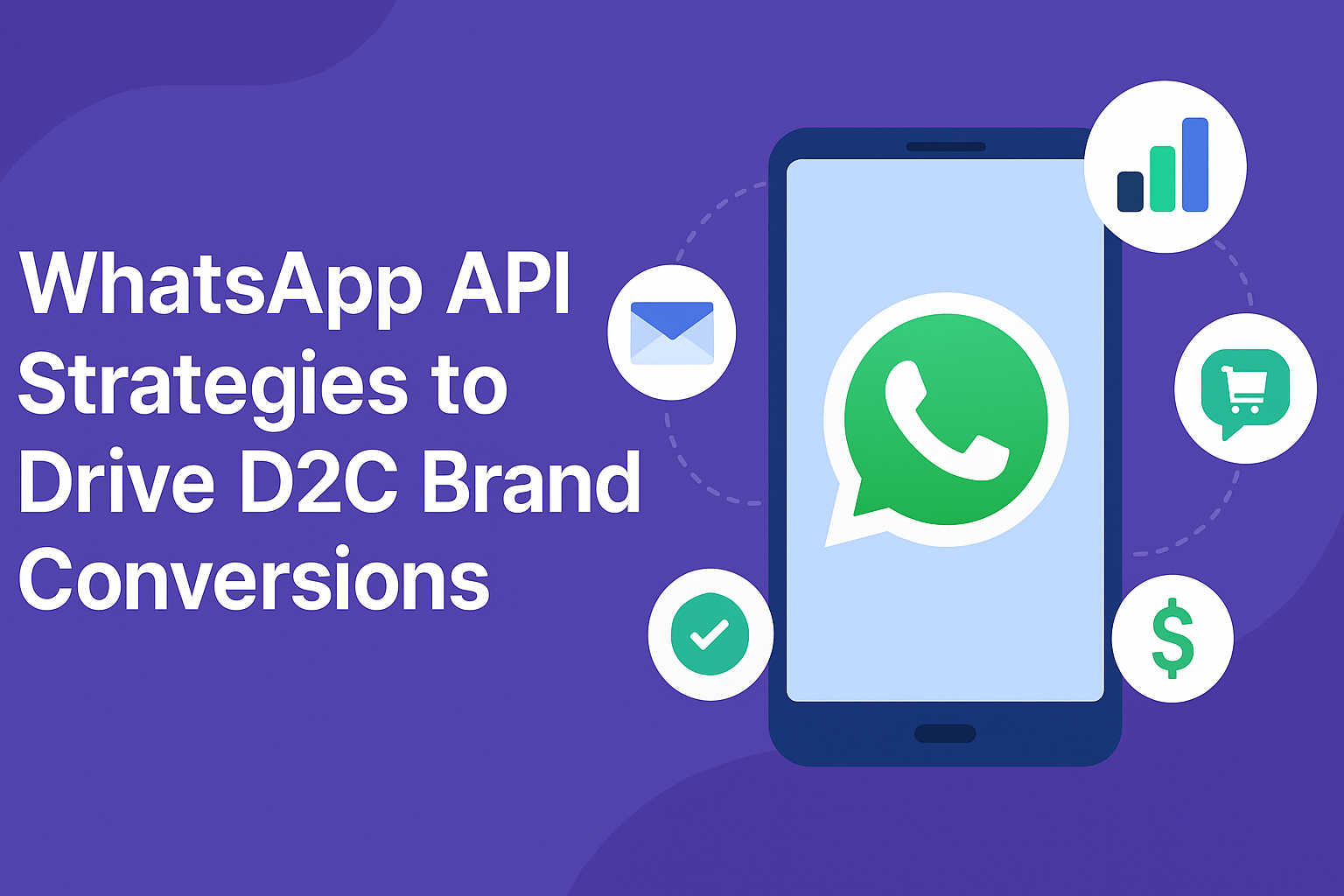
Introduction In today’s fiercely competitive D2C landscape, brands must leverage every tool to boost engagement and sales. With over 2 billion active users and open rates approaching 98%, WhatsApp Business API has emerged as a game‑changer for conversational commerce. This blog explores proven strategies—cart recovery, conversational catalogs, click‑to‑WhatsApp ads, chatbots, and payments—to help D2C brands convert more effectively. Discover how TheBotMode can facilitate this transformation with seamless integrations and automation. What Is the WhatsApp Business API? Unlike the standalone WhatsApp Business App, which is limited to a single device, the API (also known as the WhatsApp Business Platform) is built for scalability, multi-agent access, CRM integration, and advanced automation. It also enables a verified green badge, centralized logs, and enterprise-level messaging power, making it essential for growing D2C brands. Key Benefits for Driving Conversions Conversion‑Boosting Strategies 1. Automate Order Notifications & Cart Recovery Send triggered updates—order confirmations, shipping notices, low‑stock alerts—to reduce friction. Proactively reach out when carts are abandoned with personalized nudges and CTAs like “Complete your purchase now”. 2. Implement Conversational Commerce with Catalogs Engage customers directly in WhatsApp by showcasing catalogs, carousels, and quick replies. This transforms WhatsApp from a chat tool into a transactional storefront. 3. Deploy Click‑to‑WhatsApp Ads Use Meta ads to funnel leads straight into one‑to‑one conversations. Brands report 3× higher lead conversions using this strategy. 4. Run Broadcasts & VIP Communities Segment audiences to share promotions, restocks, or early‑access offers. VIP WhatsApp groups build community and exclusivity. 5. Enable Native Payments Integrate UPI or in‑chat card payments to streamline checkout and reduce cart abandonment—the U.S. market already sees broad adoption. 6. Use AI‑Driven Chatbots with Human Handoff Set up chatbots that respond 24/7, answer FAQs, route intents, then escalate to a human agent for complex queries—boosting efficiency and CX. Implementation Best Practices Success Stories & Market Trends Brands across emerging and mature markets rely on WhatsApp for growth: from Nigeria’s Torlowei to Brazil’s Lahara, many have seen sales surges of 70%+. Indian D2C brands also leverage chat commerce across diverse regions, while U.S. businesses embed APIs for transactional messaging and real-time support. As AI and omnichannel orchestration gain momentum, WhatsApp API is becoming the backbone of next-gen CX strategy. How TheBotMode Can Help At thebotmode.com, we specialize in: Our solutions help D2C brands implement high-impact strategies quickly and at scale. Conclusion & Next Steps WhatsApp Business API offers unmatched potential for D2C brand conversions—through timely notifications, conversational commerce, chat-based ads, and seamless payments. To begin: Start small, scale strategically, and watch your conversational commerce buzz—and your revenue—grow. FAQs Q1. When should a brand move from app to API? Once daily WhatsApp volume hits ~50–100 chats, or when multi-agent support, automation, CRM integration, scalable broadcast, and verification matter. Q2. What are the costs? Includes Meta conversation/message fees and BSP subscription—typically offset quickly by improved conversions. Q3. Can small D2C brands use Cloud API? Absolutely—cloud API is ideal for brands seeking fast, cost-effective setup without server management. Q4. Is WhatsApp commerce secure? Yes—end-to-end encryption, template checks, opt-in, and identity verification ensure high security. Q5. How soon can ROI be expected? Many brands begin seeing results within weeks—especially from cart recovery and click-to-WhatsApp campaigns.
Elevate Customer Support on WhatsApp: Chatbots + Human Touch
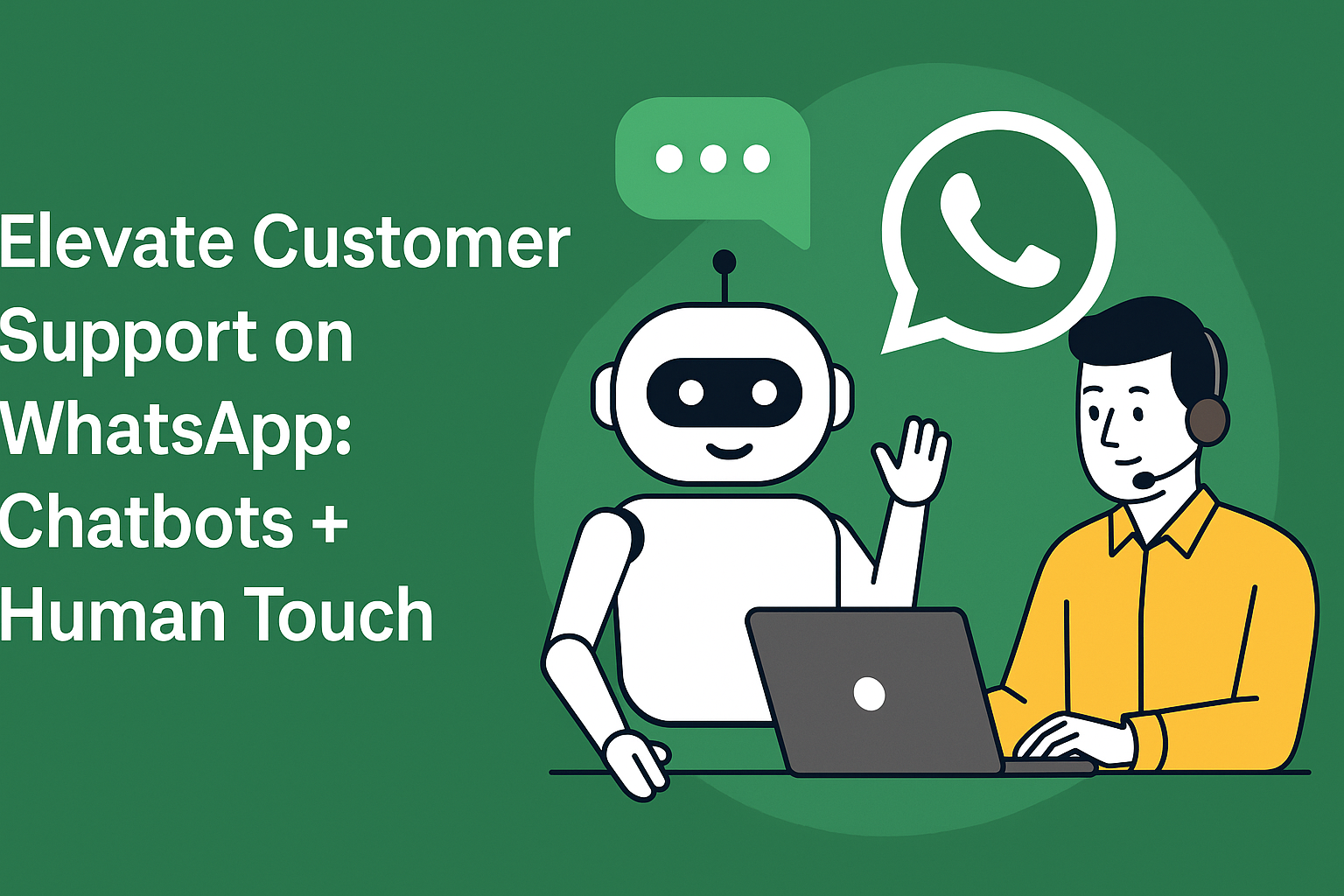
Introduction In today’s hyper-connected digital ecosystem, D2C brands must deliver fast, frictionless, and friendly support. With the explosion of mobile-first commerce, WhatsApp has emerged as the go-to communication channel for both shoppers and support teams. Why? It’s instant, conversational, and already in your customer’s pocket. But real transformation happens when you fuse automation with empathy—chatbots for customer service taking care of the repetitive, and human agents stepping in when it matters. This dynamic duo is redefining customer support on WhatsApp, making it more efficient, scalable, and lead-generating than ever before. Why WhatsApp Is the Ultimate Channel for D2C Customer Support For D2C brands, this means meeting your customers where they already are and providing instant customer service and support that drives loyalty and conversions. The Power of Chatbots for Customer Service on WhatsApp Automation through chatbots for customer service lets you: For example, a skincare D2C brand could use a WhatsApp chatbot to recommend products, offer skin quizzes, and process reorders—all while maintaining consistent tone and branding. When Human Touch Matters: Going Beyond the Bot While bots are brilliant at handling volume, they can’t replicate human empathy. Here’s where live agent support steps in: The real magic happens when your chatbot knows when to hand off to a human agent—creating a seamless support experience that feels natural and trustworthy. Implementing WhatsApp Support: Strategy + Tools Getting started with WhatsApp for customer support is easier than ever with the right stack: Your support strategy should balance automation efficiency and human warmth, ensuring every query becomes an opportunity. Driving Conversions Through WhatsApp Support Support doesn’t stop at solving problems—it’s also a powerful sales engine: A chatbot that handles a product query can seamlessly redirect users to a purchase page, while a live agent can nudge an undecided shopper toward checkout. Future of WhatsApp Support: AI + Human Synergy What’s next in the evolution of WhatsApp customer support? The future is about personalization at scale, where AI handles volume and humans drive relationships. Conclusion In a world where speed, personalization, and convenience define customer loyalty, customer support on WhatsApp is the D2C growth lever you can’t ignore. By blending the speed of chatbots with the empathy of live agents, your brand delivers not just answers but experiences. Ready to build a scalable, human-centric WhatsApp support system? Let The Botmode help you transform your customer conversations into conversions. FAQs Q1: How can WhatsApp improve customer service for D2C brands? WhatsApp offers real-time, personalized, mobile-first support that customers prefer, leading to higher satisfaction and loyalty. Q2: What kind of queries can a WhatsApp chatbot handle? Chatbots can handle FAQs, order tracking, returns, product recommendations, and initial onboarding. Q3: Is WhatsApp Business API required for chatbot integration? Yes, the API allows brands to build advanced chatbot flows and connect with agent support systems. Q4: Can I switch from bot to human chat on WhatsApp seamlessly? Absolutely. Platforms like The Bot Mode support real-time handovers for complex or high-value queries. Q5: How does WhatsApp customer support help with lead generation? It captures user data, qualifies leads through conversations, and provides timely upsell/cross-sell opportunities.













